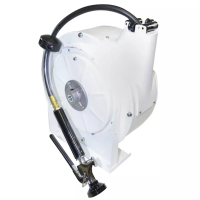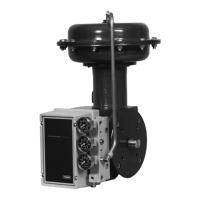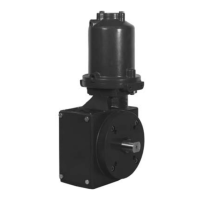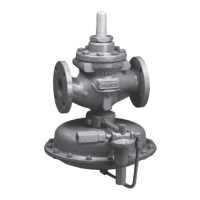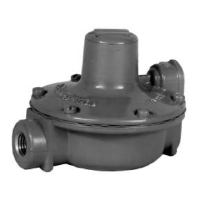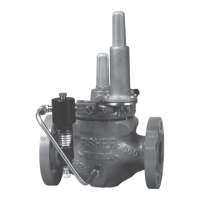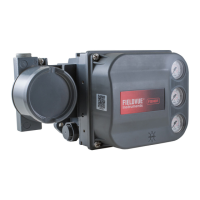4195KA, KB, and KC Series
5–4
Table
5–1. T
roubleshooting Chart (continued)
Fault CorrectionCheckPossible Cause
6. Controller will not attain full
output range
6.5 Nozzle pressure leak
6.5 Check for nozzle tubing leaks
with a water bottle and soap
solution with the nozzle capped by
the flapper. Press the nozzle cap
(key 23) gently to ensure the
nozzle assembly is sealing. Ensure
the relay nozzle tubing nut (key 18)
is tight and the manifold screws
(keys 34 and 131) are tight
6.5 Tighten the relay nozzle tubing
nut (key 18). Tighten the manifold
screws (keys 34 & 131). Replace
the nozzle assembly (key 21),
O-ring (key 24), or set point beam
assembly (key 23) as necessary if
leaking
6.6 Leak in nozzle pressure tubing 6.6 Using soap solution, check for
leaks in the nozzle tubing assembly
6.6 Replace faulty parts as
necessary. Clean out the relay
primary orifice with the cleanout
wire attached to the relay to ensure
the orifice is not clogged
6.7 Relay malfunction
6.7 Manually push the flapper
away from the nozzle. The output
pressure should be zero. Cap the
nozzle. The output should increase
rapidly to within 0.5 psig (35 mbar)
of the supply pressure
6.7 If the output does not change
as described, remove the relay.
Replace the O-rings if necessary.
Replace relay if necessary
7. Controller remains at full output
7.1 Supply pressure too high
7.1 Check with an external
pressure gauge
7.1 Supply pressure regulator or
gauge may have to be replaced
7.2 Output gauge not functioning
7.2 Reduce supply pressure to 0
psig to see if output gauge
responds
7.2 If output gauge does not
respond, replace it
7.3 Sensor or linkage failure
7.3 Vary the process pressure and
observe the flapper for movement.
Inspect the sensor and linkage for
damage
7.3 Repair or replace parts as
necessary
7.4 Flapper mis-alignment
7.4 Vary the process pressure and
verify that the nozzle can be
uncapped by the flapper
7.4 Perform flapper alignment
procedures
7.5 Relay failure or restriction in
nozzle passage
7.5 Loosen the relay nozzle tubing
nut (key 18) with full supply
pressure
7.5 If the output pressure remains
at the supply pressure, repair or
replace the relay. If the output
pressure moves to 0 psig, clean or
replace nozzle or nozzle tubing.
8. Controller remains at zero
output
8.1 Gauge not functioning
8.1 Verify that the supply pressure
is at its correct value and that the
controller output is zero
8.1 Replace gauges as necessary
8.2 Sensor or linkage failure
8.2 Vary the process pressure and
observe the flapper for movement.
Inspect the sensor and linkage for
damage
8.2 Repair or replace parts as
necessary
8.3 Flapper misalignment
8.3 Vary the process pressure and
verify that the nozzle can be
capped by the flapper.
8.3 Perform flapper alignment
procedures
8.4 Relay malfunction
8.4 Check for air at the nozzle.
Cap the nozzle and see if the
controller output increases to within
0.5 psig of supply pressure
8.4 Clean out the relay primary
orifice with the cleanout wire
attached to the relay to ensure the
orifice is not clogged. If the problem
persists, replace the relay
8.5 Nozzle pressure leak
8.5 Check for nozzle tubing leaks
with a water bottle and soap
solution with the nozzle capped by
the flapper. Press the nozzle cap
(key 23) gently to ensure the
nozzle assembly is sealing. Ensure
the relay nozzle tubing nut (key 18)
is tight and the manifold screws
(keys 34 and 131) are tight
8.5 Tighten the relay nozzle tubing
nut (key 18). Tighten the manifold
screws (keys 34 & 131). Replace
the nozzle assembly (key 21),
O-ring (key 24), or set point beam
assembly (key 23) as necessary if
leaking
3. Slide the process scale (key 61) downward so that
the top of the slot touches the set point indicator. De-
flect the lower portion of the slot outward and carefully
slide the scale up and off, clearing the set point indica-
tor as shown in figure 5–1.

